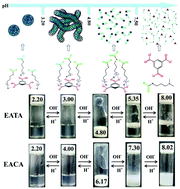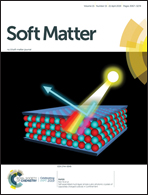Study on the effect of the organic acid structure on the rheological behavior and aggregate transformation of a pH-responsive wormlike micelle system†
Abstract
A worm-like micelle (WLM) system can be obtained by mixing long-chain cationic surfactants and polybasic organic acids in an aqueous solution. However, the effect of different organic acid structures on the rheological behavior of WLM systems has not been researched. Herein, a novel pH-responsive wormlike micelle system (EATA) was constructed by the complexation of N-erucamidopropyl-N,N-dimethylamine (UC22AMPM) and benzene tricarboxylic acid (TA) at a molar ratio of 3 : 1. UC22AMPM/citric acid (EACA) was also prepared to perform a comparison. The rheological behavior, aggregate transformation and thickening mechanism of EATA solutions were investigated by using rheological measurements, cryo-TEM, DLS, surface tension and 1H NMR. The results show that, at low pH, spherical micelles were formed and the EATA solution exhibited a lower viscosity than the EACA system due to the strong hydrophobicity of the phenyl groups of TA molecules, but the viscosity reaches 106 mP s at pH 4.80. Because of the lower pKa value of TA than CA, the viscosity of the EATA system drops sharply with the appearance of precipitates caused by the isoelectric point when the pH is greater than 4.80. In addition, by circularly changing the pH value several times, the wormlike micelles could maintain their original viscoelasticity without being weakened in the slightest.



 Please wait while we load your content...
Please wait while we load your content...